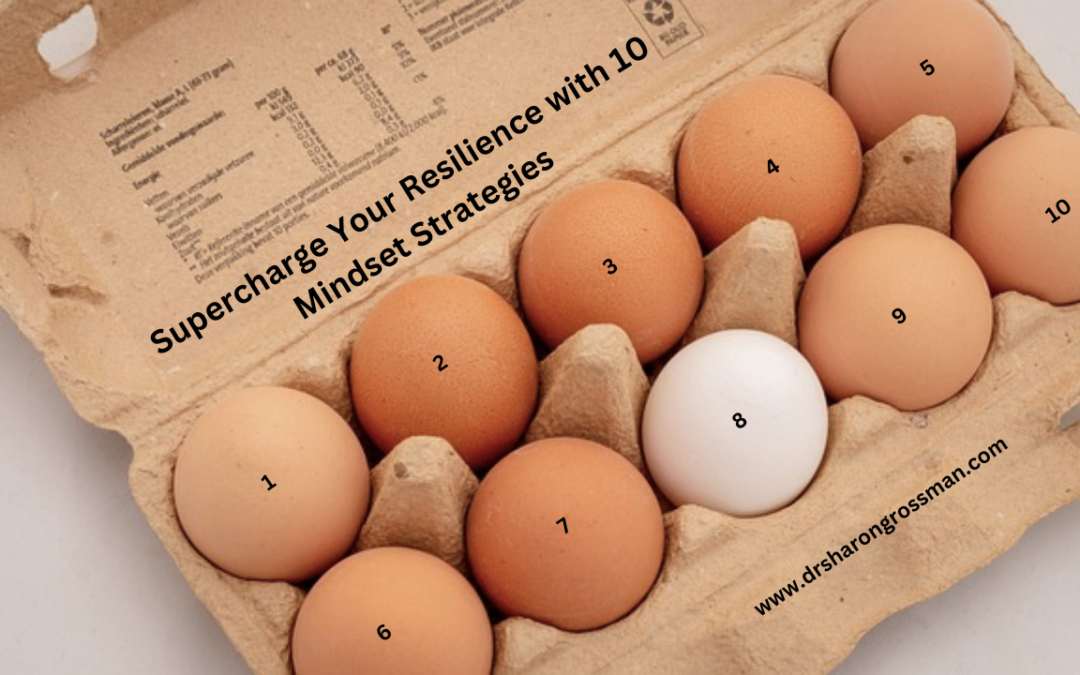What you may not realize is that resilience isn’t some elusive trait reserved for a lucky few. It’s a skill, an art that anyone can learn and master. It’s the ability to bounce back from life’s curveballs, and it’s within your reach.
Today, we’re diving into the world of resilience, unraveling the secrets behind ten powerful mindset strategies that have fueled the spirits of remarkable individuals and companies. These aren’t just strategies; they’re your keys to unlocking your inner strength which can turn life’s challenges into opportunities for triumph.
1. Embracing a Growth Mindset
Imagine you’re climbing a mountain, and each step you take feels like a struggle. The weight of your backpack, filled with doubts and fears, is pulling you down. But wait, there’s a seasoned mountaineer by your side, offering you a different perspective. They tell you that the mountain is your teacher, not your enemy. That every stumble is a lesson, every setback a stepping stone.
This shift in perspective is what we call a growth mindset. It’s the ability to view challenges not as roadblocks but as opportunities for growth. And it’s not just a fancy concept; it’s a mindset that’s powered the likes of Thomas Edison. Edison, the genius behind the light bulb, faced thousands of failures before he could illuminate the world. But he saw those failures as necessary steps toward success, not as signs to give up. Edison’s belief that every failure brought him closer to his goal reflects the magic of a growth mindset.
So, here’s the question: When life hands you lemons, do you see them as sour fruit, or do you envision the possibilities of lemonade? A growth mindset is your recipe for transforming adversity into progress. It’s about rewriting the story in your mind and discovering the silver lining in every cloud.
2. Silencing the Inner Critic
Now, imagine you’re on a stage, ready to perform in front of a massive audience. As you step into the spotlight, a voice inside your head starts to criticize your every move. It tells you that you’re not good enough, that you’ll fail, and that everyone is judging you. That voice is your inner critic, and it can be relentless.
But let’s take a detour and visit the world of Oprah Winfrey, one of the most influential media moguls in history. Oprah’s journey was anything but smooth. She faced a challenging childhood, constant criticism, and numerous setbacks. Yet, she stands as an icon of resilience. How did she do it? By learning to silence her inner critic and practicing self-compassion.
Imagine if Oprah had let that critical voice dictate her life’s story. She might never have become the inspirational figure we know today. Instead, she chose to be kinder to herself and to acknowledge that everyone stumbles from time to time. Oprah’s ability to silence the inner critic and practice self-compassion has been key to her success.
When your inner critic starts its relentless chatter, do you listen obediently, or do you challenge its authority? Resilience isn’t about silencing that voice forever; it’s about turning down the volume when it’s unhelpful and replacing criticism with self-compassion.
3. Realistic Appraisal
Apple Inc., under the visionary leadership of Steve Jobs, was riddled with both triumphs and tribulations. They released groundbreaking products, like the iPhone, but they also faced major setbacks, such as the Apple Lisa’s failure and the Macintosh’s initial struggles.
But here’s where the magic happened: Steve Jobs possessed the remarkable ability to engage in realistic appraisal. Instead of seeing these setbacks as insurmountable obstacles, he viewed them as valuable detours on the road to success. Just as your GPS recalibrates the route based on new information, Jobs adjusted Apple’s course by learning from these failed ventures.
So, how do you navigate your own uncharted territory? When you encounter setbacks or unexpected challenges, do you see them as dead ends or as opportunities for growth? Resilience isn’t about denying the existence of obstacles but about approaching them with a realistic mindset. It’s about recognizing that sometimes the treasure is found not in the destination but in the lessons learned along the way.
4. Active Problem-Solving
Imagine you’re in the cockpit of a spaceship hurtling through the cosmos. Your mission: to explore the far reaches of the universe. As you venture deeper into the unknown, you encounter unexpected obstacles—asteroid fields, gravitational anomalies, and cosmic storms. Each challenge presents a potential threat to your mission’s success.
Elon Musk is, of course, the visionary founder of SpaceX. His journey into space exploration was fraught with setbacks, particularly in the early days. SpaceX faced multiple rocket launch failures that could have spelled disaster for the company’s ambitions.
Yet, Musk’s response was akin to a seasoned astronaut facing adversity in the depths of space. He embraced active problem-solving with unwavering determination. Instead of dwelling on the failures or retreating from the challenges, Musk and his team delved into the heart of the problems, seeking innovative solutions.
No matter where you are in your life, challenges will undoubtedly arise—obstacles that threaten to divert your trajectory. Will you navigate these challenges like a skilled astronaut, approaching them as opportunities for active problem-solving? Resilience isn’t about avoiding obstacles but about embracing them as opportunities to innovate and grow.
5. Selective Thinking
Nelson Mandela spent 27 long years imprisoned, facing the greatest unknowns in his fight against apartheid. It would have been easy for him to succumb to despair, lost in the labyrinthine depths of adversity.
Thankfully, Mandela possessed a remarkable skill—a compass that guided him through the darkness. He practiced selective thinking, focusing not on the overwhelming negativity of his circumstances but on the positive vision of a reconciled South Africa. He chose to hold onto hope amidst the despair, to focus on reconciliation and forgiveness, demonstrating the power of choosing to see the positive even during times of adversity.
In your own life’s toughest moments, there will be times when the path ahead is unclear, and the shadows of doubt loom large. Will you be daunted by the darkness, or will you, like Mandela, harness the power of selective thinking?
6. Shifting from Perfectionism to Healthy Striving
The pursuit of perfection is much like the journey of J.K. Rowling, the renowned author. Before her name became synonymous with Harry Potter, she faced numerous rejections and setbacks. Her early manuscripts bore the weight of countless edits and rewrites, a testament to her unwavering commitment to excellence.
Yet, there came a pivotal moment in Rowling’s creative journey when she realized that perfection was a mirage, an unattainable ideal that only led to frustration. She understood that the pursuit of perfection often stifled progress and creativity. So, she made a profound shift—from the mindset of a perfectionist to that of a healthy striver.
In the realm of resilience, healthy striving is akin to tending a garden. Instead of obsessing over every petal’s perfection, you focus on nurturing the soil, watering the plants, and allowing them to grow at their own pace. It’s an understanding that progress, not perfection, is the true goal.
As you navigate your own path to resilience, consider the garden you tend. Are you trapped in the pursuit of perfection, or can you embrace healthy striving? Remember that resilience blossoms when you let go of the need for flawless outcomes and instead nurture growth and progress.
7. Breaking Free from the Victim Mentality
In Pakistan’s Swat Valley lived a young girl by the name of Malala Yousafzai facing the oppressive weight of the world. The Taliban had banned girls from attending school, threatening anyone who dared to defy them. Malala, undeterred by the threat to her life, continued her education and advocated for girls’ rights, defying the oppressive regime.
In the face of adversity, Malala could have succumbed to the victim mentality, blaming external circumstances for her plight. She could have surrendered to fear, allowing it to dictate her choices. But she did the opposite. Malala chose empowerment over victimhood. She took responsibility for her mission and the choices she made, demonstrating unwavering determination and bravery.
This is the essence of breaking free from the victim mentality. It’s about recognizing that you have agency in your life, even when facing the most challenging circumstances. It’s the mindset that says, “I may not control the storm, but I can navigate through it.” When you choose empowerment over victimhood, like Malala, you can defy adversity and chart a course toward a brighter future.
8. Cultivating Resilient Self-Belief
If you were around in the early days of Walt Disney’s career, you would have seen a struggling artist facing countless rejections. He had a vision of a magical world, but few believed in his dreams. Financial setbacks piled up, and it seemed like the odds were stacked against him.
In the face of relentless adversity, Walt Disney clung to one unwavering belief – his belief in himself and his vision. He possessed an unshakeable self-belief that transcended the challenges he encountered. This self-belief became the driving force behind his eventual success, giving birth to the Disney empire we know today.
Cultivating resilient self-belief isn’t reserved for the likes of Walt Disney. It’s a quality within everyone’s reach, waiting to be nurtured and strengthened. So, how can you instill this unshakeable self-belief in yourself to navigate adversity and strive for your dreams?
Ask yourself: What are your unique strengths and talents? How can you build on them to bolster your belief in yourself? Reflect on past challenges you’ve overcome, reminding yourself of your resilience. And remember, just as Walt Disney’s belief in himself transformed the entertainment industry, your self-belief can pave the way for your own remarkable journey of resilience.
9. Practicing Self-Compassion and Self-Appreciation
The tennis legend, Serena Williams, is often celebrated for her incredible career. What we sometimes forget is that throughout her career, Serena faced not only formidable opponents on the court but also a barrage of criticism, much of it unjust and steeped in bias. Yet, she never let the weight of negativity define her. Instead, she harnessed the power of self-compassion and self-appreciation as her secret weapons.
How can you apply this in your own life? Start by being kind to yourself. When you stumble or face challenges, offer yourself the same compassion and encouragement you’d give to a close friend. It’s like being your own best cheerleader, reminding yourself of your worth and resilience.
Create a journal of accomplishments, no matter how small they seem. Just as Serena celebrates her wins on the tennis court, you can celebrate your victories in life. Record your successes, no matter how minor they may appear. Reflect on your growth and progress, just as you’d admire a plant’s growth from a tiny seedling to a flourishing plant.
So, as you practice self-compassion and self-appreciation, remember that it’s not about arrogance or self-indulgence. It’s about nurturing a positive relationship with yourself, acknowledging your worth, and fueling your resilience to face whatever challenges come your way.
10. Nurturing a Sense of Purpose
Barack Obama was the 44th President of the United States and the first African American to hold this position, but it didn’t come easily. Throughout his political career, Obama faced numerous obstacles and setbacks. From his early days as a community organizer to the challenges of running a historic presidential campaign, his journey was marked by adversity.
What set Obama apart was his unwavering sense of purpose – a deep commitment to the ideals of equality, justice, and unity. This sense of purpose wasn’t just a political slogan; it was the core of his identity as a leader. It fueled his resilience and provided him with the strength to weather criticism, opposition, and even moments of self-doubt.
Your sense of purpose can act as a compass to guide you through challenges. Reflect on what truly matters to you. Consider the values, causes, or goals that resonate deeply with your heart. What drives you? What do you want to contribute to the world?
Obama’s sense of purpose was rooted in his belief in a better America, one that transcended divisions and worked toward a brighter future. This conviction sustained him through the rigors of politics and the weight of leadership. Similarly, by identifying and nurturing your sense of purpose, you can tap into a wellspring of resilience that will sustain you through life’s trials.
As you nurture your sense of purpose, remember that it’s not about the size of your ambitions; it’s about the depth of your commitment.
Conclusion
Our journey through these ten resilience techniques has revealed the remarkable power of the human spirit to bounce back and thrive. From embracing a growth mindset to nurturing a sense of purpose, each strategy offers a unique pathway to a stronger you. Remember that resilience is not a one-size-fits-all concept; it’s a deeply personal journey of growth and self-discovery.
As you embark on your own path to resilience-building, take inspiration from those who have come before you. Embrace these mindset strategies and incorporate them into your life. Remember that the power to bounce back and thrive resides within you.
—————————-
Burned out? Let me coach you to go from Exhausted to Extraordinary.
—————————-
Do you want to get my Burnout Checklist for free?
I’ve created a checklist to help you identify signs of burnout and steps to take to get immediate results. Curious?
Author

Dr. Sharon Grossman, AKA the Burnout Doc, is a clinically trained psychologist and subject matter expert in burnout and mental health. Associations and Fortune 500 companies hire her to be their closing keynote speaker, to help their members and executives crack the code on burnout, and create custom-tailored solutions for recovery.
Over the past 20 years, Dr. Sharon has been helping high achievers who are struggling with anxiety, overwhelm, and burnout go from exhausted to extraordinary by better understanding how their brain works and how they can design and run their programming on purpose to live the kind of life they want to live. She is the author of several books on burnout and mindset and host of the Decode Your Burnout podcast. Through her speaking, training, and coaching, she helps organizations keep their top talent.


Recent Comments